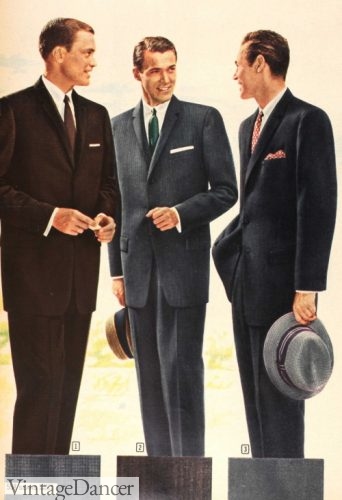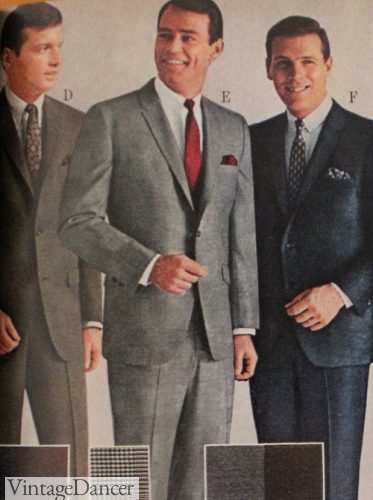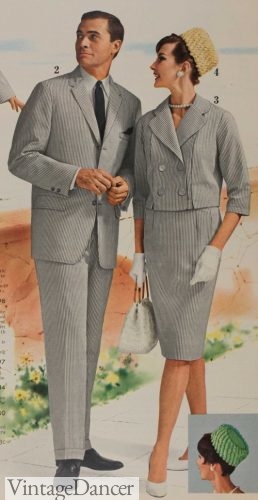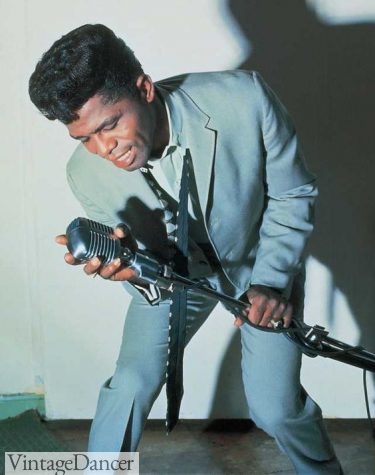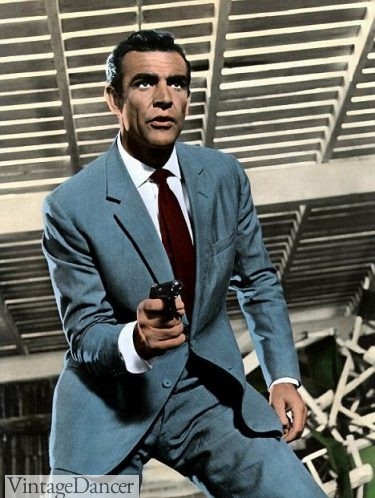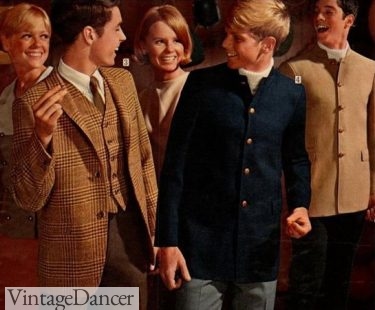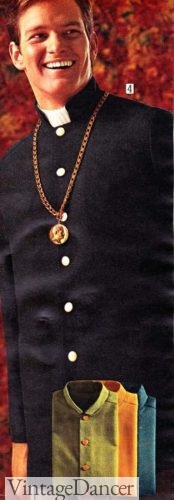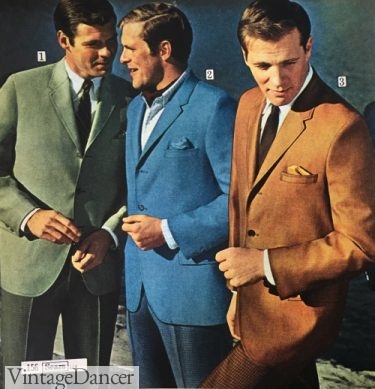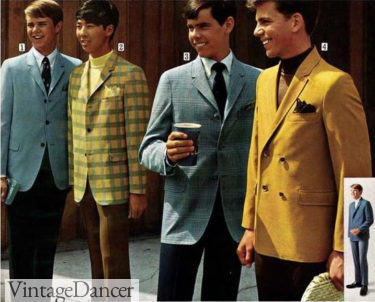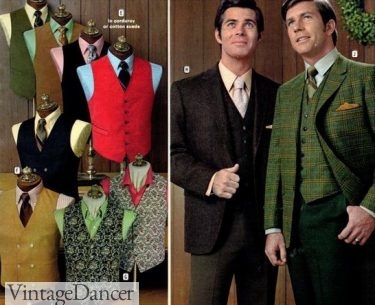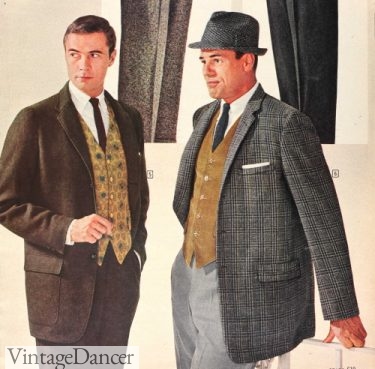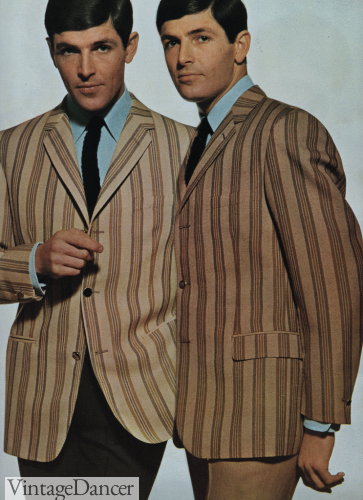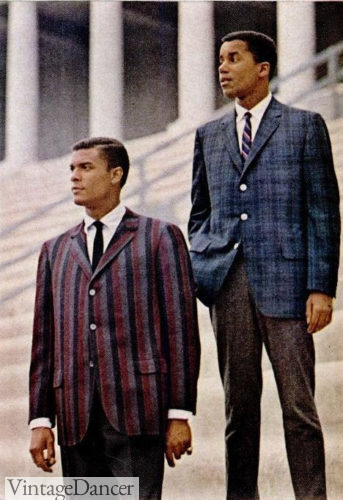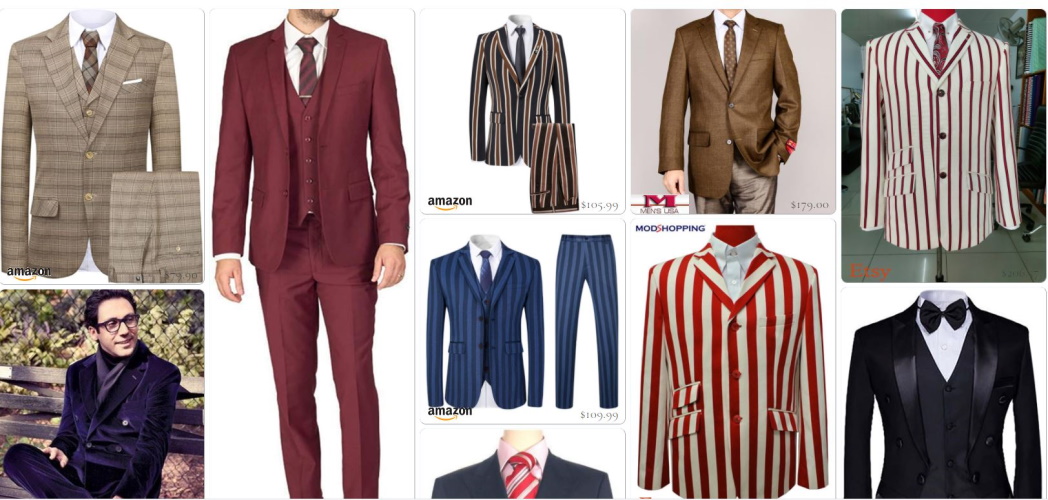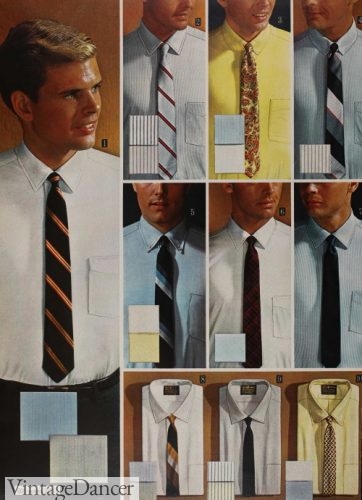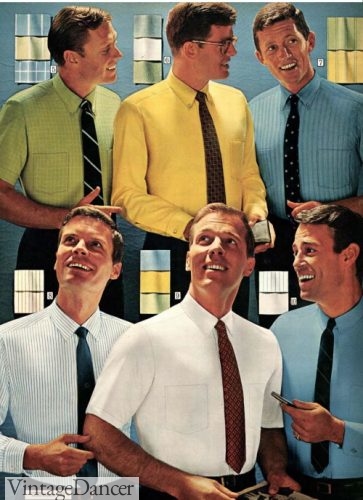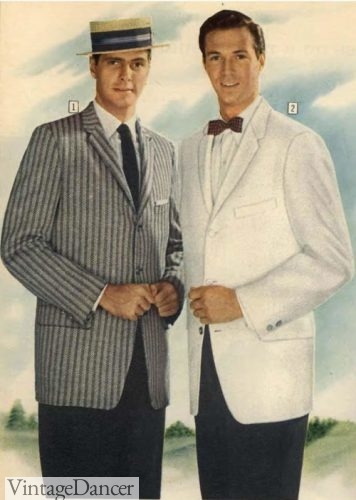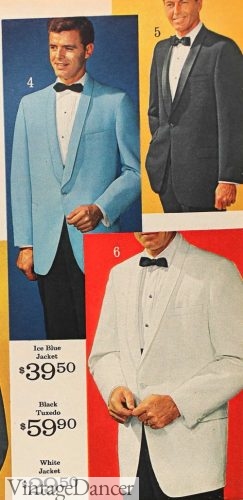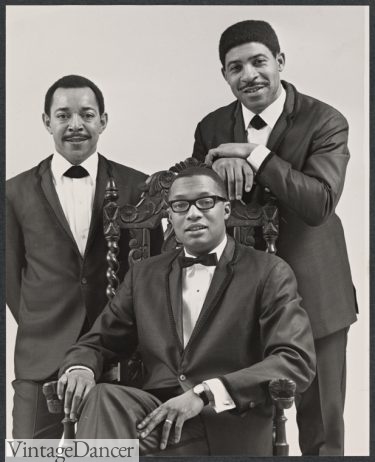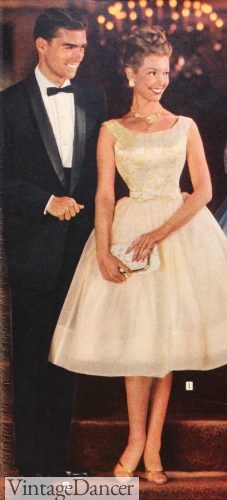Into the 1960s men’s business suits continued to be dull and lifeless in the Ivy League or Continental styles of the 1950s. Bland greys and browns with the sack fit and single pleat leg was the basic suit a business man wore to work. While there is nothing wrong this this serious look it was by no means the 1960s youthful modern suit style that was on the way.
- 1960 single breasted conservative suits
- 1960 young men’s conservative suits
Some men’s early 1960s suits were updated slightly with fabrics such as tweed, corduroy, cotton poplin, seersucker or given noticeable patterns such as plaid, checks, and herringbone. These breathed some new life into classic suits without changing the silhouette or color pallette.
- 1962 seersucker grey summer suit
- 1964 grey 3 button suit
Young men were more likely to adopt these interesting fabrics and patterns as well as the new 2 button suit jacket. Kennedy wore 2 button suit jackets and so with him a new generation of younger men in younger styles followed in his footsteps. They also favored suits with a deeper V shape jacket that made a young man appear lean. This also revealed more shirt which made the chest appear broader and more masculine. The 1 button suit followed not long after.
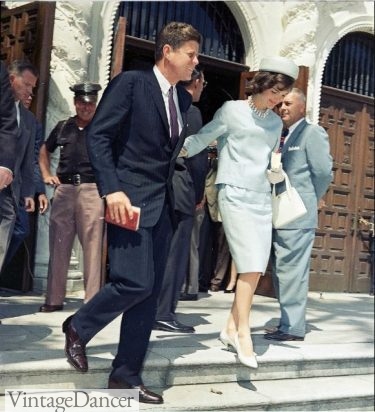
JFK wears a Brooks Brothers navy blue pinstripe two button suit
Suits were also modernized with narrowing lapels to match the skinny ties. These updated suits that were worn without a hat, often called the “JFK Look.”
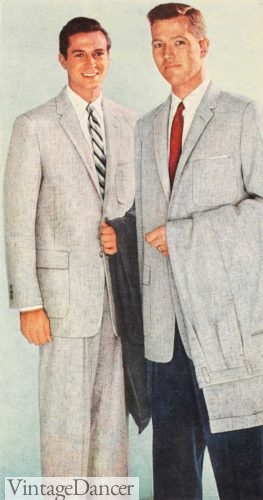
1960 young men’s splashtone two button suits
In 1961, another conservative 3 button suit jacket was dubbed the “Britisher style.” It had had padded shoulders, wider lapels, and a raised three button front.
In 1964 suits were starting to leave the doldrums behind and enter a new, lighter color palate. Iridescent mohair and silk blend fabric gave some shine to otherwise matte suiting. Dark colors lighten up to less dark shades but the overall palate was still dull.
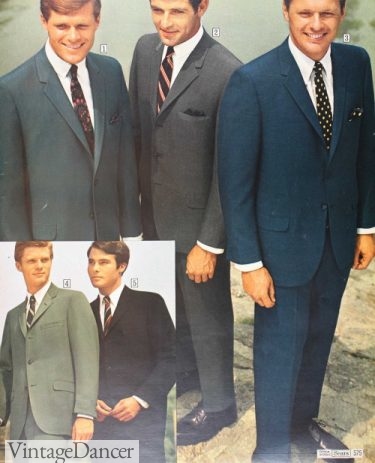
1968 lighter suit colors but still conservative
Briefly there was an ice cream color revival especially among entertainers. Robins egg blue, pink, yellow, teal or white were popping up on album covers, TV and the movies.
- 1960 James Brown wears a robins egg blue suit with conked hair
- Sean Connery as James Bond wears a blue suit
Menswear brands were trying to move suits in new, innovative directions besides colors. Lapels dabbled in different shapes: cloverleaf, L-shaped, and inverted L-shaped. Decorative details such as double stitching and leather piping were found on some jacket lapels and pockets.
Lapels were cut in all sorts of angels, different widths from very broad to very narrow, or no lapels at all. Jackets also could be buttoned with one to 16 buttons. The fit was slimmer and shorter than conservative suits.
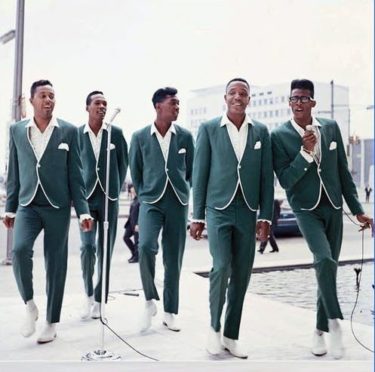
Temptations, green collarless suits with white piping and white boots
In the later 1960s the American suit was heavily inspired by the British mods. Collars disappeared and in their place came the high Napoleonic collar, short stand up collar, and collarless jackets.

1965 mandarin stand up collar and no lapels
One particular late 60s suit jacket was called the Nehru. It was a Chinese inspired long tunic jacket with short stand collar, 5 spaced out buttons and two almost vertical side pockets. Colors and patterns were rich and varied. So were the trim, buttons, cuffs and pockets. On top of that men wore large gold chain necklaces with jeweled pendants and grew out their sideburns. The age of the peacocked male was coming.
- 1968 nehru jackets in navy blue or camel
- 1968 black nehru jacket with gold chain pendant necklace
1960s Sport Coats
As basic as men’s suits were for most of the 1960s, it was not a colorless decade. The sport coat had a long history of interesting patterns and more varied colors since the late 1920s. In the 1960s the patterns and especially colors erupted into a vibrant, eye-popping, modern mayhem. Brilliant yellows, deep mustard, and golden sand mixed with dark navy, green and rust brown.
- 1968 summer sport coats with matching pocket squares
- 1969 solid or plaid sport coats for the mods
At first patterns were small checks, plaid and windowpane but large plaid became the signature print of the mid to late 60s. Solid color sport coats were the same sharp colors as prints but could also be soft pastels, creams and light greys for the conservative men.
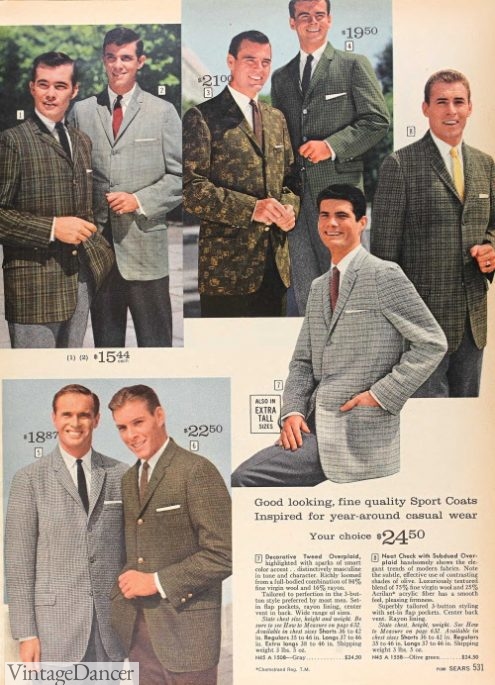
1961 summer sport coats, light colors, small prints
Some jackets featured a slight cutaway front, a nod back to the Edwardian era. Most American’s preferred the straight front jacket with natural shaped shoulders. Both single and double breasted varieties were worn.
Tweed was also revived from the 1900s but so was a newer camel tan wool flannel jacket. Vineyard colors such as grape, burgundy, olive green, and whisky tan become the color palette of the mid 60s.
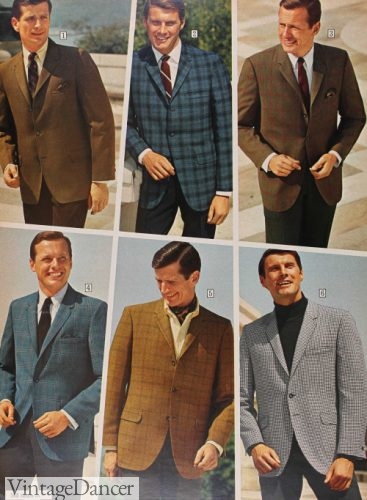
1968 mens sport coats
Young men loved sport coats and blazers in primary colors of red, yellow, green and blue. They were worn with dark trousers and a brightly colored solid shirt (turtlenecks or button down) to make the most impact.
The Ivy League kids wore mismatched suit jackets and pants with a bold colored 5 button suit vest or sweater vest. Red and yellow were the most popular vest colors that popped under dark blue, grey, or tan sport coats. Dark vests could be worn with lighter colored jackets.
- 1969 sport coats and vests
- 1960, mature men also wore colored vests
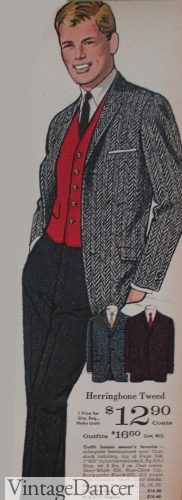
1964 Ivy league look- tweed grey sport coat, red vest, black tweed trousers
The vertical striped sport coat for the early 60s was also a nod back to early times when the “boating” blazer was a signature Ivy League uniform for rowing teams as well as music groups. The 60s version was much more colorful with multiple color stripes.
- 1960 tan boating stripes
- 1960s, boater stripe and plaid sportcoats
In the fall and winter seasons the smooth blazer type sport coat was booted for the rough tweeds, Shetlands, hairy cheviots in dark earth tones.
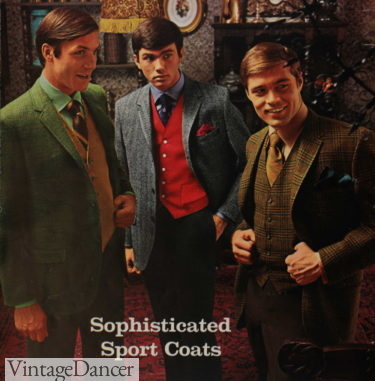
1969 sportscoat, sweater vests, tie and trousers- all in mismatched colors and patterns
Shop men’s 60s suits and sportscoats
Men’s 1960s Dress Shirts
The biggest shirt news of the 1960s was the permanent press process called durable press which went mainstream in the mid 1960s. Dress shirt style followed those of the late 1950s with plain white, single pocket, shirts with short spread or small point collars. The fit was slimmed down, like suits, all over the torso and arms.
Short sleeve shirts were even more popular in the 1960s and had one but more likely two pockets. Plastic pocket protectors kept ink from staining crisp white shirts.
By the end of the decade men were calling out for more colors and bigger collars (both long and wide.)
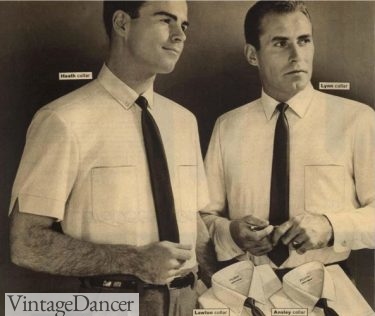
1961 men’s short sleeve and two pocket dress shirts
- 1966 Men’s Dress Shirts and Ties
- 1968 Men’s Colorful Dress Shirts
Men’s 1960s Formal Suits
The early 60s tuxedo trends continued from the 1950s.
- The all black tuxedo with a thin shawl collar was the most traditional when worn with a black or white vest and bow tie.
- The white shawl or notch collar tuxedo jacket with black trousers was a newer look that most men preferred.
- The ice blue jacket was the newest look and most recognizable to the 1960s. Other colors were worn but not nearly as trendy as blue. A black or color bow tie and cummerbund brought it into a semi-formal state.
- 1960 white sport coat doubles as a tuxedo coat
- 1964 blue, black or white tuxedo jackets
- Ramsey Lewis trio wears tuxedos with bulldogger ties and bow tie
- 1960 black shawl collar tuxedo
Like men’s suits, formalwear took on some of the same attempts at updating. Piping, edging, cutaway jackets, Nehru collars, velvet lapels were some of the innovations. Soul musician and entertainers often led these new looks such as fabulously dressed Temptations.
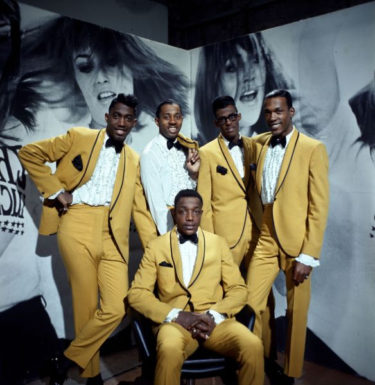
Photo by Fremantle Media/REX/Shutterstock (3004296cp)
The Temptations
‘Thank Your Lucky Stars’ TV Programme, 1961 – 1966
Debbie Sessions has been teaching fashion history and helping people dress for vintage themed events since 2009. She has turned a hobby into VintageDancer.com with hundreds of well researched articles and hand picked links to vintage inspired clothing online. She aims to make dressing accurately (or not) an affordable option for all. Oh, and she dances too.
